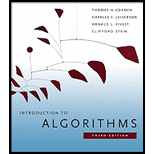
(a)
To show the number of possible seams grows exponential.
(a)
Explanation of Solution
Consider an array A for the compressing the picture so it requires to remove the pixels in the two adjacent rows in the same or adjacent column and the pixels are removed forms a seam from the top row to the bottom row.
Suppose
The total area enclosed by the seams is order of m and it has two choices for every area of m so the total probability of the total number of seams can be varies from 2m to 2m -1.
Hence, the total number of possibilities of seams is bounded by
(b)
To give an algorithm that finds a seam with lowest disruption measure.
(b)
Explanation of Solution
The algorithm to find a seam with the lowest disruption is given below:
Seam(A)
Initialize tables
For
End for.
for
for
If
If
End if.
Else
End if.
Else if(
If() then
End if.
End if.
End for.
End for.
For
If
End if.
End for.
Print the list
End.
The algorithm compressing the picture so it requires to removes the pixels in the two adjacent rows in the same or adjacent column and the pixels are removed forms a seam from the top row to the bottom row.
This algorithm takes the array A as input and the cases to insert pixel according to the defined condition and return the list of seam as
Want to see more full solutions like this?
Chapter 15 Solutions
Introduction to Algorithms
- Brand managers know that increasing promotional budgets eventually result in diminishing returns. The first one million dollars typically results in a 26% increase in awareness, while the second million results in adding another 18% and the third million in a 5% increase. Andrews’s product Alan currently has an awareness level of 80% . While an important product for Andrews, Alan’s promotion budget will be reduced to one million dollars for the upcoming year. Assuming that Alan loses one-third of its awareness each year, what will Alan’s awareness level be next year? a) 79% b) 53% c) 74% d) 58%arrow_forwardDo not use A.I and solve completelyarrow_forwardSolve thisarrow_forward
- Specifications: Part-1Part-1: DescriptionIn this part of the lab you will build a single operation ALU. This ALU will implement a bitwise left rotation. Forthis lab assignment you are not allowed to use Digital's Arithmetic components.IF YOU ARE FOUND USING THEM, YOU WILL RECEIVE A ZERO FOR LAB2!The ALU you will be implementing consists of two 4-bit inputs (named inA and inB) and one 4-bit output (named out). Your ALU must rotate the bits in inA by the amount given by inB (i.e. 0-15).Part-1: User InterfaceYou are provided an interface file lab2_part1.dig; start Part-1 from this file.NOTE: You are not permitted to edit the content inside the dotted lines rectangle.Part-1: ExampleIn the figure above, the input values that we have selected to test are inA = {inA_3, inA_2, inA_1, inA_0} = {0, 1, 0,0} and inB = {inB_3, inB_2, inB_1, inB_0} = {0, 0, 1, 0}. Therefore, we must rotate the bus 0100 bitwise left by00102, or 2 in base 10, to get {0, 0, 0, 1}. Please note that a rotation left is…arrow_forwardHow can I perform Laplace Transformation when using integration based on this? Where we convert time-based domain to frequency domainarrow_forwardwhat would be the best way I can explain the bevhoirs of Laplace and Inverse Transofrmation In MATLAB.arrow_forward
- What IETF protocol is NetFlow associated with? Group of answer choices IPX/SPX IPIX HTTPS SSHarrow_forwardHow can I perform Laplace Transformation when using integration based on this?arrow_forwardWrite an example of a personal reflection of your course. - What you liked about the course. - What you didn’t like about the course. - Suggestions for improvement. Course: Information and Decision Sciences (IDS) The Reflection Paper should be 1 or 2 pages in length.arrow_forward
 New Perspectives on HTML5, CSS3, and JavaScriptComputer ScienceISBN:9781305503922Author:Patrick M. CareyPublisher:Cengage Learning
New Perspectives on HTML5, CSS3, and JavaScriptComputer ScienceISBN:9781305503922Author:Patrick M. CareyPublisher:Cengage Learning Systems ArchitectureComputer ScienceISBN:9781305080195Author:Stephen D. BurdPublisher:Cengage Learning
Systems ArchitectureComputer ScienceISBN:9781305080195Author:Stephen D. BurdPublisher:Cengage Learning Fundamentals of Information SystemsComputer ScienceISBN:9781305082168Author:Ralph Stair, George ReynoldsPublisher:Cengage Learning
Fundamentals of Information SystemsComputer ScienceISBN:9781305082168Author:Ralph Stair, George ReynoldsPublisher:Cengage Learning C++ Programming: From Problem Analysis to Program...Computer ScienceISBN:9781337102087Author:D. S. MalikPublisher:Cengage LearningProgramming Logic & Design ComprehensiveComputer ScienceISBN:9781337669405Author:FARRELLPublisher:Cengage
C++ Programming: From Problem Analysis to Program...Computer ScienceISBN:9781337102087Author:D. S. MalikPublisher:Cengage LearningProgramming Logic & Design ComprehensiveComputer ScienceISBN:9781337669405Author:FARRELLPublisher:Cengage C++ for Engineers and ScientistsComputer ScienceISBN:9781133187844Author:Bronson, Gary J.Publisher:Course Technology Ptr
C++ for Engineers and ScientistsComputer ScienceISBN:9781133187844Author:Bronson, Gary J.Publisher:Course Technology Ptr





